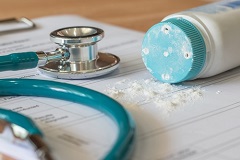 More than 100 years ago, Johnson & Johnson began selling baby powder. From generation to generation, people have used it to keep skin dry and soft. You may have happy memories of using it with your children or it may be part of your daily routine, and because of the product’s history and marketing, you may have never thought about whether the talcum-based powder was safe.
More than 100 years ago, Johnson & Johnson began selling baby powder. From generation to generation, people have used it to keep skin dry and soft. You may have happy memories of using it with your children or it may be part of your daily routine, and because of the product’s history and marketing, you may have never thought about whether the talcum-based powder was safe.
Talcum Powder and Ovarian Cancer
Talc is a mineral, chemically known as hydrated magnesium silicate. It is one of the softest minerals known. When talc is pulverized, the dust produced—known as talcum powder—easily absorbs liquids.
Some studies—stretching back at least to 1971—have indicated a potential connection between talcum powder and ovarian cancer. Since 1999 the American Cancer Society has recommended that women use a cornstarch-based powder rather than a talcum-based powder on genitals. Additionally, many consumers who have developed ovarian cancer have raised concerns about the product’s safety.
At least one court has found a potential link between Johnson & Johnson Baby Powder and ovarian cancer. In February 2016, a jury awarded $72 million to the estate of a woman who died in October 2015 after using baby powder and developing ovarian cancer.
Johnson & Johnson maintains that talcum-based powder is safe for genital use and has not issued any warnings about ovarian cancer. Warnings on the company’s baby powder product indicate that the product should not be inhaled and that should only be used externally.
As of April 2015, there have been no warnings from the Federal Drug Administration (FDA) about the safety of talcum-based powders. However, baby powder is considered to be a cosmetic and does not require FDA approval.
What Did Johnson & Johnson Know When?
Let’s consider the history of Johnson & Johnson’s Baby Powder:
- In 1894, Johnson & Johnson’s Baby Powder went on the market. It was made of 99.8% talc and it was marketed to ease diaper rash.
- In the early 1900s, Johnson & Johnson began marketing the product to women also.
- In 1982, a study was published in the journal Cancer that showed a statistical link between using talc powder on genitals and ovarian cancer. A Johnson & Johnson representative met with the epidemiologist who conducted the study.
- By the mid-1980s adults made up 70 percent of the market for Johnson & Johnson Baby Powder.
- In 1997, an internal Johnson & Johnson memo from a medical consultant indicated that anyone who denies the link between the hygienic use of talc and ovarian cancer is “denying the obvious in the face of all evidence to the contrary.”
- In 2006, Luzenac (now called Imerys), the company that provides talc to Johnson & Johnson, included a warning on its safety data sheet indicating that perineal use of talc powder could be a possible risk factor for ovarian cancer.
- In 2014, baby powder accounted for about $324 million in sales for Johnson & Johnson—a small piece of the large company’s profits, but an important piece of gaining consumer trust.
- As of April 2016, Johnson & Johnson continues to maintain that talc powder is safe.
Since 1982, 20 additional studies have indicated that long-term use of talc-based powders in the genital area may raise the risk of ovarian cancer by approximately 33 percent. Other studies, however, have found that there is no increased risk of ovarian cancer linked to the use of talcum powder.
Lawsuits Filed Against Johnson & Johnson
More than 1,000 women or their families are suing Johnson & Johnson and its supplier of talc, Imerys. These women claim that Johnson & Johnson and Imerys knew about the association between talcum powder and ovarian cancer and the companies failed to warn women about the potential danger. Some of these cases have been resolved and some are still pending. Consider, for example, the cases of:
- Jacqueline Fox. In February 2016, a Missouri jury ordered Johnson & Johnson to pay her family a total of $72 million in damages—$10 million in actual damages and $62 million in punitive damages. Ms. Fox died in October 2015 from ovarian cancer after using Johnson & Johnson’s Baby Powder and Shower to Shower products for more than 35 years. Ms. Fox was 62 years old when she died. The jurors found Johnson & Johnson liable for fraud, negligence, and conspiracy.
- Deane Berg. In October 2013, a federal jury in South Dakota found that use of talcum powder was a factor in her development of ovarian cancer, but the jury failed to award her financial damages.
Approximately, 1,200 lawsuits are currently pending against Johnson & Johnson alleging that the company’s baby powder caused ovarian cancer.
What to Do If You Develop Ovarian Cancer After Repeated Use of Johnson & Johnson Talcum Powder
It can be hard to think about a product that you trusted has caused you to develop ovarian cancer. Ovarian cancer is often discovered when it is already at a late stage and it may be difficult to recover from. If you developed this condition because Johnson & Johnson failed to warn you about the potential link about its talc based baby powder and ovarian cancer then you should speak with an experienced lawyer is prepared to go up against pharmaceutical giants such as Johnson & Johnson. For more information, please contact us today via this website or by calling 888-450-4456.
RELATED LINKS: